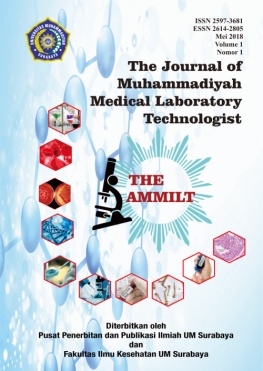Main Article Content
Abstract
Â
abstract
Nira is a raw material for the manufacture of liquid brown sugar, palm sugar, and alcoholic beverages. Among these products are the most widely used alcoholic beverage. During this siwalan juice as a beverage consumed fresh, the storage period is relatively short whice for 1-2 days. If after 3 days the beverage is consumed will have a negative impact, to reduce the alcohol content is then made warming. Based on the above background can be taken formulation of the problem "whether there was an effect on levels of alcohol prolonged heating on sap siwalan"?. The purpose of this study was to determine whether there was an effect on levels of alcohol prolonged heating on sap siwalan. This research is a kind of experimental research with the aim to determine the effect of prolonged heating of the alcohol content in the sap siwalan. The sampling technique used was random sampling, totaling 24 samples. Variable work was composed of independent variables and the dependent variable. Alcohol Examination conducted on sap siwalan by doing without heating or 0 minutes, 10 minutes, 20 minutes and 30 minutes, using a number of methods Pycnometer six replication. From these results a decrease in the average alcohol content of sap siwalan on any heating for 10 min, 20 min and 30 min, after using ANOVA statistical test obtained p = 0.000 (p <0.05) can be summed Ha Ho is rejected or accepted which means there is prolonged heating effect on levels of alcohol in the juice siwalan.
Key word : Nira, Level of alcohol, prolonger heating
Â
Article Details
References
- Anonim. 2008 Peraturan Menteri Kesehatan RI NO. 86/ Men. Kes/ Per/ IV/77 tentang : Bahan Tambahan Makan Direktorat Pengawasan Obat dan Makanan, Departemen Kesehatan RI. Jakarta
- Arintawati. 2006. Mengenal minuman beralkohol. http://www.republika.co.id. Diakses tanggal 06 April 2012.
- Buckle, K. A, Edwards, R.A, Fleet, G.H. and Wooton, M. 1985. Ilmu Pangan. UI-Press. Jakarta.
- Estu Patriyatno, S. 2006. Keunikan legen. http://.id.wikipedia.org/wiki/Siwalan. Diakses tanggal 14 Maret 2012.
- Ferdiaz. 1992. Mikrobiologi Pangan 1. PT. Gramedia Utama Pustaka. Jakarta.
- Frisna, 2008. Reaksi- reaksi senyawa karbon, http : // kimia, upl. Edu/ bahan ajar/ reaksi_organik/ index, htm, diakses : 24 April 2012
- Gusti, diah, 2010, Isolasi gasohol dari limbah nira aren (Arenga pinnata merr) Jurnal Penelitian Kelapa. Vol.2 N0.2.
- Hidayat, dkk. 1997. Mikrobiologi Industri. Yogyakarta: Penerbit Andi.
- Irine Rizki C dkk, 2006. Tuak dan Legen, http :// www.id.wikipedia. org/wiki/siwalan. Diakses : 17 Mei 2012
- Joseph, G.H.M.M, M. Rumokoi dan Z. Mahmud. 1990. Perbaikan teknik penyadapan nira lontar di Nusa Tenggara Timur. Buletin Balitka No. 11 Thn 1990 hlm. 103 – 111, Balai Penelitian Kelapa. Manado.
- Lempang, M., A. Kadir, W. dan Misdarti. 2003. Teknologi pengolahan nira aren untuk produk nata pinnata. Buletin No.6 Thn. 2003 Badan Penelitian dan Pengembangan Daerah Propinsi Sulawesi Selatan. Makassar.
- Mahmud, Z., D. Allorerung dan Amrizal, 1991. Prospek tanaman kelapa, aren, lontar dan gewang, untuk menghasilkan gula. Buletin Balitka No. 14 Thn. 1991 hlm. 90 – 105. Balai Penelitian Kelapa. Manado.
- Rukmana. 1998. Ganyong budidaya dan pasca panen. Yogyakarta: Kanisius
- Sunanto H. 1993. Aren (Budidaya dan Multigunanya). Yogyakarta : Kanisius
- Sriwulan, wieke. 2002. Penuntun praktikum kimia makanan dan minuman. Surabaya
- Sudjana. 1996, Metoda satistika. Edisi 6. Bandung : Kanisius
- Widjanarko. 2008. Siwalan dan kandungan niranya. http://www.lintas berita.com diakses tanggal 14 Mei 2012.
- Wikipedia, 2010. Etanol, http://www.wikipedia.org. diakses tanggal 28 Mei 2012.
References
Anonim. 2008 Peraturan Menteri Kesehatan RI NO. 86/ Men. Kes/ Per/ IV/77 tentang : Bahan Tambahan Makan Direktorat Pengawasan Obat dan Makanan, Departemen Kesehatan RI. Jakarta
Arintawati. 2006. Mengenal minuman beralkohol. http://www.republika.co.id. Diakses tanggal 06 April 2012.
Buckle, K. A, Edwards, R.A, Fleet, G.H. and Wooton, M. 1985. Ilmu Pangan. UI-Press. Jakarta.
Estu Patriyatno, S. 2006. Keunikan legen. http://.id.wikipedia.org/wiki/Siwalan. Diakses tanggal 14 Maret 2012.
Ferdiaz. 1992. Mikrobiologi Pangan 1. PT. Gramedia Utama Pustaka. Jakarta.
Frisna, 2008. Reaksi- reaksi senyawa karbon, http : // kimia, upl. Edu/ bahan ajar/ reaksi_organik/ index, htm, diakses : 24 April 2012
Gusti, diah, 2010, Isolasi gasohol dari limbah nira aren (Arenga pinnata merr) Jurnal Penelitian Kelapa. Vol.2 N0.2.
Hidayat, dkk. 1997. Mikrobiologi Industri. Yogyakarta: Penerbit Andi.
Irine Rizki C dkk, 2006. Tuak dan Legen, http :// www.id.wikipedia. org/wiki/siwalan. Diakses : 17 Mei 2012
Joseph, G.H.M.M, M. Rumokoi dan Z. Mahmud. 1990. Perbaikan teknik penyadapan nira lontar di Nusa Tenggara Timur. Buletin Balitka No. 11 Thn 1990 hlm. 103 – 111, Balai Penelitian Kelapa. Manado.
Lempang, M., A. Kadir, W. dan Misdarti. 2003. Teknologi pengolahan nira aren untuk produk nata pinnata. Buletin No.6 Thn. 2003 Badan Penelitian dan Pengembangan Daerah Propinsi Sulawesi Selatan. Makassar.
Mahmud, Z., D. Allorerung dan Amrizal, 1991. Prospek tanaman kelapa, aren, lontar dan gewang, untuk menghasilkan gula. Buletin Balitka No. 14 Thn. 1991 hlm. 90 – 105. Balai Penelitian Kelapa. Manado.
Rukmana. 1998. Ganyong budidaya dan pasca panen. Yogyakarta: Kanisius
Sunanto H. 1993. Aren (Budidaya dan Multigunanya). Yogyakarta : Kanisius
Sriwulan, wieke. 2002. Penuntun praktikum kimia makanan dan minuman. Surabaya
Sudjana. 1996, Metoda satistika. Edisi 6. Bandung : Kanisius
Widjanarko. 2008. Siwalan dan kandungan niranya. http://www.lintas berita.com diakses tanggal 14 Mei 2012.
Wikipedia, 2010. Etanol, http://www.wikipedia.org. diakses tanggal 28 Mei 2012.

